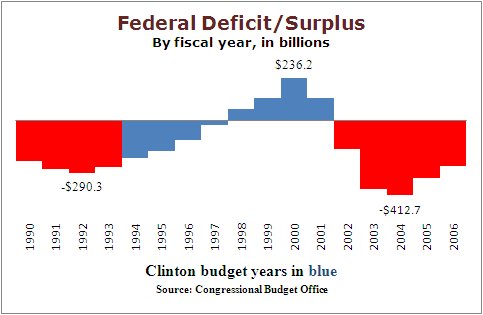Q: During the Clinton administration was the federal budget balanced? Was the federal deficit erased?
A: Yes to both questions, whether you count Social Security or not.
FULL ANSWER
This chart, based on historical figures from the nonpartisan Congressional Budget Office, shows the total deficit or surplus for each fiscal year from 1990 through 2006. Keep in mind that fiscal years begin Oct. 1, so the first year that can be counted as a Clinton year is fiscal 1994. The appropriations bills for fiscal years 1990 through 1993 were signed by Bill Clinton’s predecessor, George H.W. Bush. Fiscal 2002 is the first for which President George W. Bush signed the appropriations bills, and the first to show the effect of his tax cuts.
The Clinton years showed the effects of a large tax increase that Clinton pushed through in his first year, and that Republicans incorrectly claim is the “largest tax increase in history.” It fell almost exclusively on upper-income taxpayers. Clinton’s fiscal 1994 budget also contained some spending restraints. An equally if not more powerful influence was the booming economy and huge gains in the stock markets, the so-called dot-com bubble, which brought in hundreds of millions in unanticipated tax revenue from taxes on capital gains and rising salaries.
Clinton’s large budget surpluses also owe much to the Social Security tax on payrolls. Social Security taxes now bring in more than the cost of current benefits, and the “Social Security surplus” makes the total deficit or surplus figures look better than they would if Social Security wasn’t counted. But even if we remove Social Security from the equation, there was a surplus of $1.9 billion in fiscal 1999 and $86.4 billion in fiscal 2000. So any way you count it, the federal budget was balanced and the deficit was erased, if only for a while.
Update, Feb. 11: Some readers wrote to us saying we should have made clear the difference between the federal deficit and the federal debt. A deficit occurs when the government takes in less money than it spends in a given year. The debt is the total amount the government owes at any given time. So the debt goes up in any given year by the amount of the deficit, or it decreases by the amount of any surplus. The debt the government owes to the public decreased for a while under Clinton, but the debt was by no means erased.
Other readers have noted a USA Today story stating that, under an alternative type of accounting, the final four years of the Clinton administration taken together would have shown a deficit. This is based on an annual document called the “Financial Report of the U.S. Government,” which reports what the governments books would look like if kept on an accrual basis like those of most corporations, rather than the cash basis that the government has always used. The principal difference is that under accrual accounting the government would book immediately the costs of promises made to pay future benefits to government workers and Social Security and Medicare beneficiaries. But even under accrual accounting, the annual reports showed surpluses of $69.2 billion in fiscal 1998, $76.9 billion in fiscal 1999, and $46 billion for fiscal year 2000. So even if the government had been using that form of accounting the deficit would have been erased for those three years.
– Brooks Jackson
